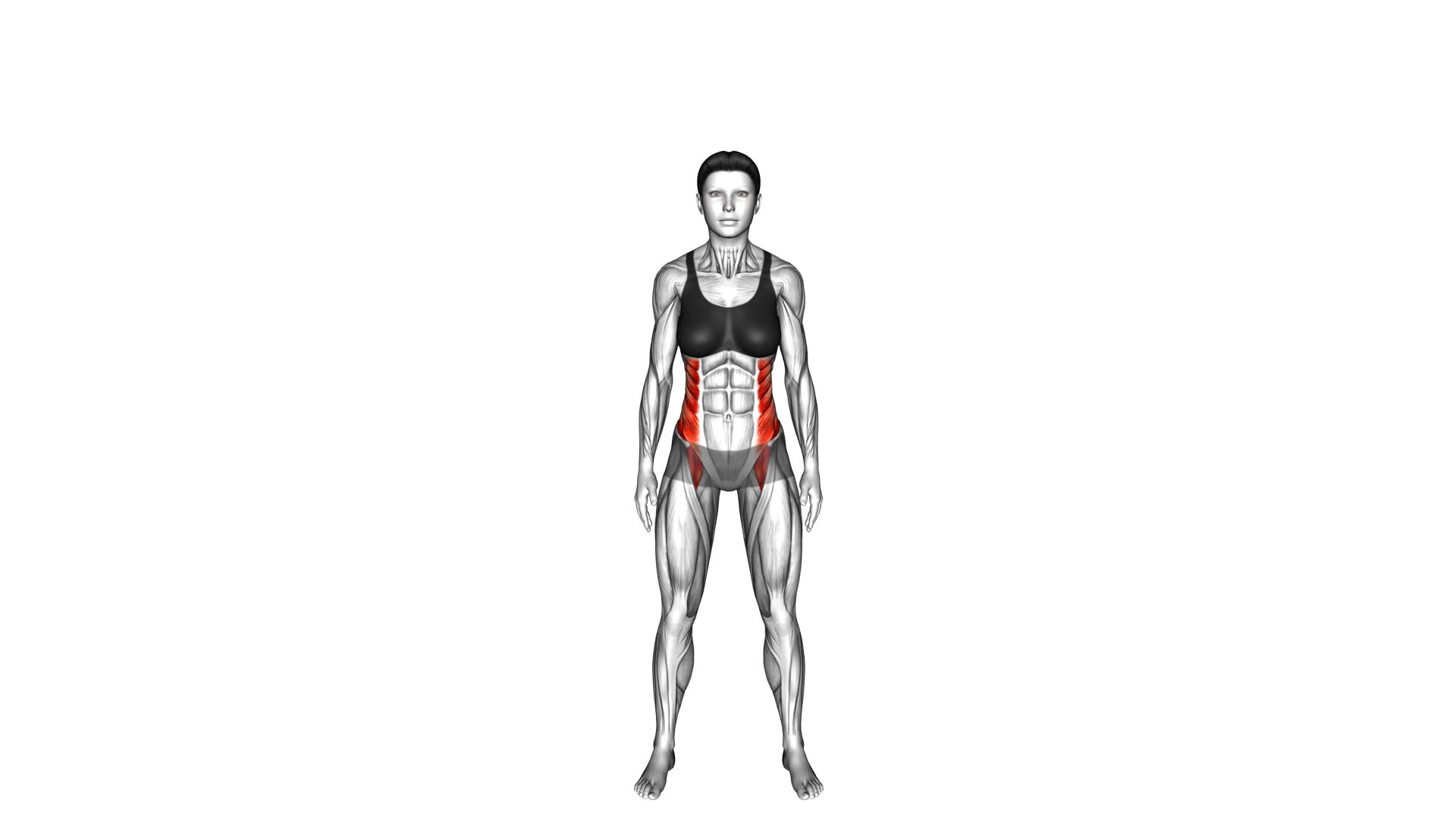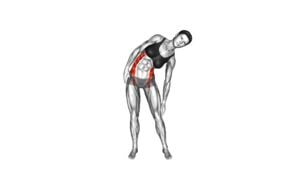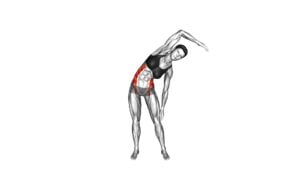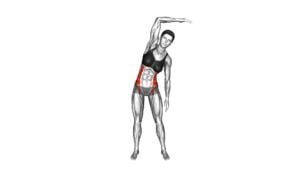Standing Side Bend (VERSION 2) (female) – Video Exercise Guide & Tips

Are you looking to strengthen your core and improve your flexibility?
Watch This Exercise Video
Then you'll love the standing side bend (version 2) exercise!
In this video exercise guide, we'll show you the proper form and technique to perform this exercise effectively.
You'll also find helpful tips and modifications to suit your fitness level.
Avoid common mistakes and maximize your results with this informative and concise guide.
Get ready to feel the burn and achieve your fitness goals!
Key Takeaways
- Targets oblique muscles and engages core, back, and shoulders
- Improves core strength, stability, and flexibility in the spine
- Modifiable with range of motion, resistance, and arm position
- Avoid common mistakes such as using excessive weight, leaning too far forward or backward, rushing through the movement, neglecting proper breathing technique, and maintaining proper alignment and control.
Benefits of Standing Side Bend (Version 2)
Experience the numerous benefits of the Standing Side Bend (Version 2) exercise. This exercise offers various variations that can be incorporated into your workout routine for maximum results.
The Standing Side Bend is an effective exercise that primarily targets the oblique muscles, but also engages the core, back, and shoulders.
One of the benefits of the Standing Side Bend is improved core strength and stability. By engaging the oblique muscles, this exercise helps to tone and strengthen the core, resulting in better posture and balance. Additionally, the Standing Side Bend can help to increase flexibility in the spine, promoting better range of motion in daily activities and reducing the risk of lower back pain.
To incorporate the Standing Side Bend into your workout routine, start by standing with your feet hip-width apart and your arms extended overhead. From this position, bend your upper body to the side, lowering your arm towards your thigh while keeping your hips stable. Hold the position for a few seconds before returning to the starting position. Repeat on the other side.
For a variation, you can use dumbbells or a resistance band to add resistance to the exercise. This will further challenge your muscles and increase the intensity of the workout. Remember to start with lighter weights and gradually increase as your strength improves.
Incorporating the Standing Side Bend into your workout routine can help to strengthen and tone your core, improve flexibility, and enhance overall posture and balance. Add this exercise to your fitness regimen and experience the benefits for yourself.
Proper Form and Technique
To perform the Standing Side Bend (Version 2) exercise with proper form and technique, ensure that your feet are hip-width apart and your arms are extended overhead. This exercise is often misunderstood, so let's clear up some common misconceptions.
First, it's important to maintain a straight spine throughout the movement, avoiding any excessive rounding or arching of the back. Keep your core engaged to support your lower back. Another misconception is that you need to touch your toes or the floor with your hand. Instead, focus on creating a lateral bend by reaching your arm towards the opposite side, keeping your body in a straight line.
Now, let's talk about variations and modifications. If you have limited flexibility, you can start by performing the exercise with your hands resting on your hips, gradually increasing the range of motion as you become more comfortable. You can also use a resistance band or a dumbbell to add intensity to the exercise. Additionally, if you have any shoulder issues, you can perform the side bend with your arms extended out to the sides at shoulder height, instead of overhead.
In the next section, we'll discuss modifications and progressions that can help you take your Standing Side Bend (Version 2) exercise to the next level.
Modifications and Progressions
To modify or progress the Standing Side Bend (Version 2) exercise, you can adjust the range of motion, add resistance, or increase the difficulty level.
If you're a beginner or have limited flexibility, you can start by reducing the range of motion. Instead of bending to the side as far as possible, only go as far as feels comfortable for you. Gradually increase the range of motion as you become more comfortable with the exercise.
To add resistance and make the exercise more challenging, you can hold a dumbbell or a resistance band in your hand while performing the side bend. The added weight will engage your muscles more intensely and help you build strength.
For advanced variations, you can try performing the exercise on an unstable surface, such as a Bosu ball or a balance board. This will challenge your core stability and increase the difficulty level of the exercise.
Another advanced variation is to combine the Standing Side Bend with a rotation. As you bend to the side, rotate your torso towards the ceiling or the floor. This will engage your oblique muscles from different angles and provide a more comprehensive workout.
Remember to always listen to your body and make modifications or progressions based on your individual fitness level and goals.
Common Mistakes to Avoid
Avoid these common mistakes when performing the Standing Side Bend (Version 2) exercise.
To ensure you get the most out of this exercise and avoid potential injuries, it's important to be aware of these troubleshooting tips.
One common mistake is using excessive weight or resistance. It's important to start with a weight that's appropriate for your current fitness level. Using too much weight can strain your muscles and increase the risk of injury. Start with a lighter weight and gradually increase as you build strength and stability.
Another mistake to avoid is leaning too far forward or backward during the side bend. This can compromise your posture and put unnecessary strain on your back. Keep your spine straight and engage your core muscles to maintain proper alignment throughout the exercise.
Additionally, rushing through the movement is a common error. It's crucial to perform the side bend slowly and with control to fully engage the targeted muscles. Focus on the contraction and extension of your side muscles, and avoid using momentum to complete the exercise.
Lastly, neglecting proper breathing technique is a mistake to be aware of. Remember to inhale deeply before initiating the side bend and exhale as you return to the starting position. Proper breathing helps to stabilize your core and maximize the effectiveness of the exercise.
Tips for Maximizing Results
Maximize your results by incorporating these tips into your Standing Side Bend (Version 2) exercise routine.
Staying motivated is key to achieving your fitness goals. To stay motivated, set realistic goals for yourself and track your progress. Celebrate small achievements along the way to keep yourself motivated and engaged in your workout routine.
Nutrition plays a crucial role in optimizing your results. Fuel your body with the right nutrients by incorporating a balanced and nutritious diet. Include a variety of fruits, vegetables, lean proteins, and whole grains in your meals. Stay hydrated by drinking plenty of water throughout the day.
To enhance your results, consider incorporating other exercises that target your core muscles. Combining different exercises can help you strengthen your core and improve your overall fitness. Adding variety to your routine can also prevent boredom and keep you motivated.
Listen to your body and don't push yourself too hard. Make sure to warm up before starting your exercise routine and cool down afterward to prevent injury. Rest and recover adequately to allow your muscles to repair and grow.
Frequently Asked Questions
How Often Should I Perform the Standing Side Bend (Version 2) Exercise?
To determine how often you should perform the standing side bend (version 2) exercise, it's important to consider your fitness level and goals. Generally, experts recommend incorporating this exercise into your routine 2-3 times a week.
However, if you have lower back pain, it's crucial to consult with a healthcare professional before attempting this exercise. They can assess your condition and advise if it's safe for you to perform the standing side bend (version 2) or suggest modifications to avoid aggravating your lower back pain.
Can the Standing Side Bend (Version 2) Help Me Reduce Belly Fat?
Yes, the standing side bend (version 2) can help strengthen the obliques and tone the waistline. This exercise targets the muscles on the sides of your abdomen, making them stronger and more defined.
By incorporating this exercise into your routine, along with a balanced diet and regular cardio exercise, you can effectively reduce belly fat and achieve a slimmer waistline.
Stay consistent and remember to consult with a fitness professional for personalized guidance.
Is It Safe to Perform the Standing Side Bend (Version 2) if I Have Lower Back Pain?
If you have a history of lower back pain, you may want to avoid the standing side bend (version 2) exercise. It could potentially aggravate your condition. Instead, focus on exercises that strengthen your core and promote proper posture.
However, if you still want to perform the standing side bend, you can modify it by using a smaller range of motion or by using a stability ball for support.
Always listen to your body and consult with a healthcare professional before starting any new exercise routine.
Can the Standing Side Bend (Version 2) Exercise Help Improve My Posture?
The standing side bend (version 2) exercise can definitely help improve your posture. By incorporating variations of this exercise into your routine, you can target and strengthen the muscles in your core and back, which are crucial for maintaining proper posture.
To ensure you're performing the exercise correctly, focus on maintaining proper form and technique. Engage your core, keep your back straight, and avoid any jerky or excessive movements.
Consistency and proper execution will yield the best results.
What Are Some Alternative Exercises I Can Do to Target the Same Muscle Groups as the Standing Side Bend (Version 2)?
Looking for alternative exercises to target the same muscle groups as the Standing Side Bend (Version 2)?
Incorporating exercises like lateral lunges, seated side bends, and Russian twists can help you engage and strengthen those muscles.
These exercises work your obliques, core, and lower back, promoting better posture and overall stability.
Conclusion
In conclusion, the standing side bend (version 2) is a beneficial exercise that targets the obliques and core muscles. By practicing proper form and technique, and making modifications or progressions as needed, you can maximize the effectiveness of this exercise.
Avoiding common mistakes and following the provided tips will also help you achieve the best results. Incorporate the standing side bend (version 2) into your fitness routine to strengthen and tone your side muscles.

Author
Years ago, the spark of my life’s passion ignited in my mind the moment I stepped into the local gym for the first time. The inaugural bead of perspiration, the initial endeavor, the very first surge of endorphins, and a sense of pride that washed over me post-workout marked the beginning of my deep-seated interest in strength sports, fitness, and sports nutrition. This very curiosity blossomed rapidly into a profound fascination, propelling me to earn a Master’s degree in Physical Education from the Academy of Physical Education in Krakow, followed by a Sports Manager diploma from the Jagiellonian University. My journey of growth led me to gain more specialized qualifications, such as being a certified personal trainer with a focus on sports dietetics, a lifeguard, and an instructor for wellness and corrective gymnastics. Theoretical knowledge paired seamlessly with practical experience, reinforcing my belief that the transformation of individuals under my guidance was also a reflection of my personal growth. This belief holds true even today. Each day, I strive to push the boundaries and explore new realms. These realms gently elevate me to greater heights. The unique combination of passion for my field and the continuous quest for growth fuels my drive to break new ground.







